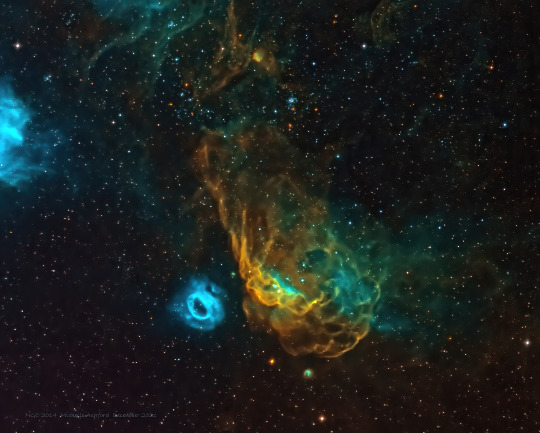#NGC 2020
Text

The "Cosmic Reef" in the LMC // Alex Woronow
#astronomy#astrophotography#nebula#emission nebula#star-forming region#NGC 2020#NGC 2014#NGC 2011#NGC 2035#NGC 2032#NGC 2029#NGC 2040#LMC#large magellanic cloud#dorado
52 notes
·
View notes
Text

NGC 2020
#astronomy#astronomers#nasa#universe#astrophotography#nasa photos#astrophysics#outer space#nasawebb#hubble space telescope#astronews#astrography#i love astronomy#astro community#space science#planetary nebula#planetary science#science
671 notes
·
View notes
Text

Nebula NGC 2014 and NGC 2020.
Credit: NASA, ESA, and STScI.
#space#science#nature#astronomy#Universe#Cosmos#Astrophotography#NASA#night sky#stars#astro community#outer space#astrophysics#cosmology#nebula
310 notes
·
View notes
Text
Tapestry of Blazing Starbirth

This image is one of the most photogenic examples of the many turbulent stellar nurseries the NASA/ESA Hubble Space Telescope has observed during its 30-year lifetime. The portrait features the giant nebula NGC 2014 and its neighbour NGC 2020 which together form part of a vast star-forming region in the Large Magellanic Cloud, a satellite galaxy of the Milky Way, approximately 163,000 light-years away.
95 notes
·
View notes
Text

^ Comet C/2020 V2 (ZTF) glowing green near three galaxies in Grus. Credit: Damian Peach
From Phil Plait's 'Bad Astronomy Newsletter':
Wow, that’s pretty, isn’t it? The comet in the shot is C/2020 V2 (ZTF), and the galaxies are collectyively called the Grus Triplet, because they’re close together in the constellation Grus (the Crane). The galaxies are NGC 7590, 7599, and 7582, and they’re about 70 million light-years away. NGC 7582 is an active galaxy, with a central supermassive black hole that’s gobbling down matter. This stuff forms a huge, hot disk around the black hole, so hot it launches a powerful wind of gas away so hard it plows into the galaxy around it. Winds like this can enhance star birth by compressing clouds, but if they’re too powerful they can push that material clean out of the galaxy, quenching star formation.
The comet is interesting, too. It was discovered in 2020 by the Zwicky Transient Facility, which scours the sky looking for objects that move or change brightness. The orbit of this comet is hyperbolic, which means it’s moving too quickly to stay bound to the Sun. Objects that are bound to the Sun gravitationally have elliptical orbits, and ones that are just barely not bound move along a parabola. If they have too much energy, are moving too quickly, the orbital shape is a hyperbola.
Continue reading: https://badastronomy.substack.com/p/under-italian-skies-the-comet-and
29 notes
·
View notes
Note
favorite image you've taken of the night sky, go
this is harder to decide than i expected like in terms of how pretty i find the image it's probsbly between these three (I may have a bias towards golden brown scenes)
but there's a few images I havent posted that I also really like for other reasons

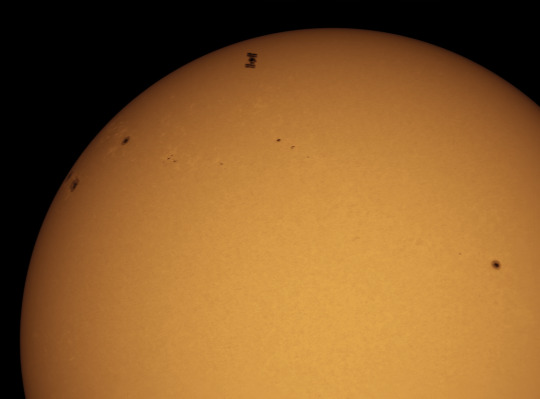

like yea comets are badass I love them that comet pic is of comet leonard which was the first comet i ever managed to observe and photograph
ISS transits of the sun and moon are particularly special because like. you gotta travel to the exact location to capture it, it happens in less than a second it's like an astrophotography sport. And the rush you get for succeeding and being able to see the ISS on your screen is crazy. like that's a thing that humans put up there damn ...
the last pic is A bit hard to see but it's a pic 4 or 5 days before the great conjunction of jupiter and saturn in 2020, showing the actual relative positions of the moon, jupiter, saturn and the ISS as I was able to see them for that short moment (well technically it's 12 composited frames of the ISS moving across the frame) There's no considerable detail on anything except the moon (you can kinda see saturn's shape too) cuz they were all near the horizon. but I was insanely lucky to be right next to one of the only places in the world to be able to capture this particular quadruple alignment... I think I've only seen one other photo of the great conjunction with the ISS next to it like this. And like I literally only found out this was happening like 15 minutes before it actually happened, it was a total rush to capture this shot lol
and like shoutout to this unfinished photo of comet ZTF I have no idea how to process so all I have right now are these WIP pics lol. I really really like the composition though If I gave this data to a professional astrophotographer I bet they could make something amazing from it
27 notes
·
View notes
Text
Сказка на ночь.
Туманность NGC 2014, расположенная на расстоянии 163 000 световых лет от нас в Большом Магеллановом Облаке, галактике-спутнике нашего Млечного Пути.
Позже можно увидеть голубое кольцо светящегося кислорода в соседней туманности NGC 2020.
Голубое свечение образовалось в результате мощного газового потока из одинокой массивной сверхгорячей звезды в её центре.
And this is the NGC 2014 nebula, located 163,000 light-years away in the Large Magellanic Cloud, a satellite galaxy of our Milky Way.
Later, a blue ring of glowing oxygen can be seen in the nearby NGC 2020 nebula.
The blue glow was formed as a result of a powerful gas stream from a single massive super-hot star in its center.
52 notes
·
View notes
Text
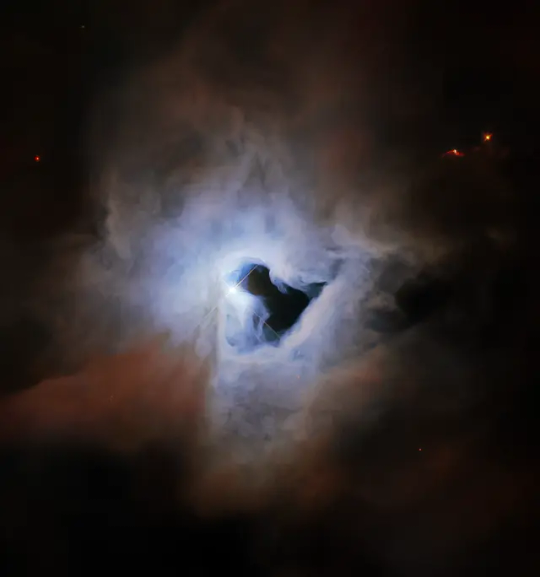
NGC 1999
ESA/Hubble & NASA, ESO, K. Noll

THE Cosmic Keyhole, or by the government name of NGC 1999, is a reflection nebula in the Orion constellation. Located near the Orion Nebula, in a region of the Milky Way where stars are actively being formed, NGC 1999 is ~1350ly from Earth and is the composition of young star’s (V380 Orionis) formation discards.
UNLIKE emission nebulae, which alone emit light due to radiation ionization involving stars’ ultraviolet rays and nebula’s hydrogen atoms, NGC 1999 can’t shine unless a fixed light source illuminates the nebula due to its reflective type. The Cosmic Keyhole, however, is brightened by V380 Orionis (the light diffracting in the image above), a T Tauri star that sits covered by the smog of its birth.
REGARDING the “keyhole,” astronomers initially thought the hole was a Bok globule, a dense molecular cloud of gas and cosmic dust that absorbs light. In 2009, further observations were conducted using the Herschel Space Observatory (an infrared telescope that can penetrate dense material such as in this case), with supporting analyses from the Atacama Pathfinder Experiment, Nicholas U. Mayall Telescope, and the Magellan telescopes, debunking the Bok globule belief—instead concluding that NGC 1999’s mark isn’t anything but empty space. To this day, it’s still unknown why NGC 1999 has its iconic hole, but experts speculate that its creation is from local, new stars’ jets of gas puncturing the nebula’s foggy wall.
THE nebula was first discovered in the late 18th century by astronomer siblings Sir William and Caroline Herschel. It was later listed as object 1999 in the New General Catalogue—hence its formal name. In 1999, shortly after Servicing Mission 3A, the WFPC2 observations captured the image above.

CAPTION SOURCES
Main article w/ picture: "Hubble Peers at Mysterious Cosmic ‘Keyhole’" (NASA).
ADS
| "Hier ist wahrhaftig ein Loch im Himmel. The NGC 1999 dark globule is not a globule"
A&A
| "Herschel: the first science highlights"
CfA
| "Bok Globules"
ESA/Hubble
| "Cosmic Keyhole"
NASA
| "The Reflection Nebula in Orion"
| "NGC 1999"
| "Hubble's Nebulae"
| "Hubble Images Bok Globules"

(Caption written by @kaitropoli (me) using information from the sources above. Astronomy--knowledge of the universe, its population, fundamentals, and how everything is *known* to operate--is expanding every day with new things being discovered; the information listed could expire, so note that what I've gathered spans from 1990-2010 (with particular articles from the 2020s affirming up-to-date information with unchanged data).)

#NASA#ESAHubble#hubble#ESA#astronomy#space#nebula#nebulae#telescope#cosmic#cosmickeyhole#ngc1999#1999#science#stars#reflectionnebula#herschel#newgeneralcatalogue#milkyway#history
2 notes
·
View notes
Text
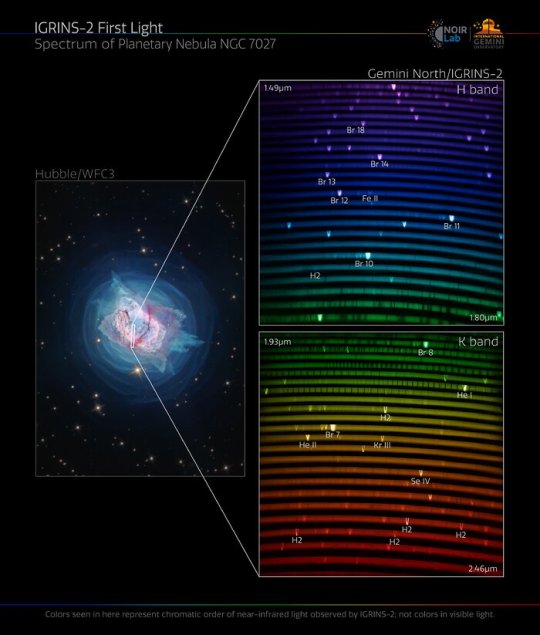

Gemini North Peers Deeper Into the Dust with New Instrument
IGRINS-2, a new high-resolution near-infrared spectrograph on Gemini North, sees First Light
Gemini North, one half of the International Gemini Observatory operated by NSF’s NOIRLab, is now peering deeper into the dusty dwellings of young stars with its new IGRINS-2 instrument. This next-generation spectrograph is an upgraded version of the high-demand visiting instrument IGRINS on Gemini South that will expand our understanding of cosmic objects shrouded by dust and gas.
IGRINS-2 (Immersion GRating INfrared Spectrograph-2) has set its ‘eyes’ on the sky for the first time. Mounted on the Gemini North telescope, one half of the International Gemini Observatory operated by NSF’s NOIRLab, the new instrument obtained spectra of the planetary nebula NGC 7027, nicknamed the Jewel Bug Nebula. NGC 7027 is one of the visually brightest planetary nebulae, and its resplendent rosette — made of layers of gas ejected during the dying breaths of its central star — makes for an exciting first light target.
Spectrographs are arguably the most important science instruments in all of astronomy. Unlike high-resolution cameras that capture amazing details of distant stars, galaxies and nebulae, spectrographs precisely analyze the spectrum of light emitted by these objects, revealing detailed information about their chemical composition. The expansion of NGC 7027’s dynamic gasses out into the surrounding space produces a striking spectrum that illustrates the power of the instrument.
“With the new infrared IGRINS-2 on Gemini North complementing the new optical GHOST on Gemini South, we now have two cutting-edge high-resolution spectrographs,” said Jennifer Lotz, Director of Gemini Observatory. “This expanded capability of our observatory opens up exciting windows of discovery.”
Although its first spectrum is of the death throes of a star, IGRINS-2 is actually designed to witness the first moments of nascent stars. “The main science goal of IGRINS-2 is observing young stars being born inside a dusty environment,” said IGRINS-2 Project Manager and Technical Representative Hwihyun Kim. While these dusty birthplaces are impenetrable to visible light, a near-infrared spectrograph like IGRINS-2 can pierce through the dust and observe young stars in their early development.
With its ability to see through gas, dust, and other opaque materials, IGRINS-2 is also well-suited to studying brown dwarfs, exoplanets, the interstellar medium and the evolution of galaxies. Not only is IGRINS-2 able to see through dust, it does so with remarkable resolution, allowing astronomers to resolve details about stellar atmospheres and the structures of galaxies.
IGRINS-2 was built by the Korea Astronomy and Space Science Institute (KASI) on behalf of the International Gemini Observatory. Initiated in March 2020, this instrument was constructed during the COVID-19 pandemic. “It has been gratifying to see our efforts come to fruition,” said KASI Principal Investigator Chan Park. “We delivered this instrument and its components without any delays — all in the middle of a global pandemic — thanks to the valiant efforts of our team and our partners at Gemini Observatory.”
During the highly-anticipated first-light event, excitement filled the Gemini North control room as IGRINS-2 captured its first spectra. “It’s difficult to describe the emotion of people when they saw the first observations; it was a mix of excitement, awe, relief, and joy,” said Ruben Diaz, Gemini’s acting Associate Director of Development. Kim adds that she was told by her Gemini North colleagues they had never seen so many people in the control room at one time.
Following this significant milestone, the KASI and Gemini teams will begin integrating IGRINS-2 with the software and subsystems at Gemini North, a process that will take several months. Gemini staff will then be trained in maintaining and operating the instrument. In addition, documentation will be developed to assist the user community with the instrument. IGRINS-2 will be available for use by the broader astronomy community in the second half of 2024.
“The ability of IGRINS-2 to peer within otherwise opaque regions of the Universe will allow us to better understand how stars are born and many other astronomical phenomena hidden behind galactic dust,” said Martin Still, NSF Program Director for the International Gemini Observatory. “NSF congratulates our Gemini partner, KASI, and the entire telescope staff for achieving the critical milestone of IGRINS-2 first light.”
TOP IMAGE....IGRINS-2 resolves the dynamic gaseous bubble surrounding NGC 7027, the Jewel Bug Nebula. The bright lines in the rainbow are like the fingerprints of the gasses present in the nebula. Credit: International Gemini Observatory/NOIRLab/NSF/AURA/NASA/ESA/J. Kastner (RIT) Image Processing: M. Zamani (NSF’s NOIRLab)
LOWER IMAGE.... This mosaic shows the two IGRINS-2 spectra of NGC 7027, nicknamed the Jewel Bug Nebula, captured by the Gemini North telescope, one half of the International Gemini Observatory operated by NSF’s NOIRLab. NGC 7027 is one of the visually brightest planetary nebulae, and its resplendent rosette — made of layers of gas ejected during the dying breaths of its central star — makes for an exciting first light target whose spectrum illustrates the power of Gemini North’s new instrument. The two IGRINS-2 spectra shown here, which were produced in the same single observation, measure light from around 1.49 µm to around 2.46 µm. The bright lines in the rainbow are like the fingerprints of the gasses present in the nebula. Notice how the emission lines have a V-shape. This is due to NGC 7027’s expanding gas bubble, with some gas moving towards the observer and some gas moving away along the observer's line of sight. Some lines appear sharp due to very dense layers of hydrogen which light can't penetrate much, while some appear fuzzy due to the less dense hydrogen layers. Credit: International Gemini Observatory/NOIRLab/NSF/AURA Image Processing: M. Zamani (NSF’s NOIRLab)
3 notes
·
View notes
Text
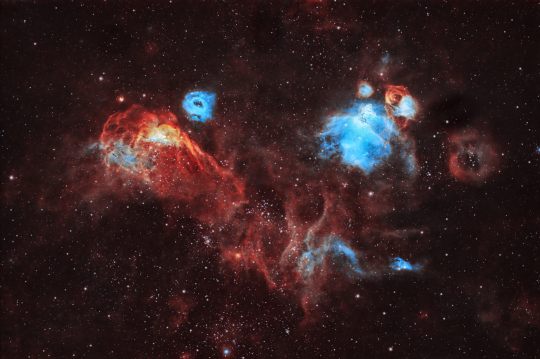
The Cosmic Reef in the LMC // Richard Bamfield
Included in this image are the nebulae (from left to right): NGC 2014 (red), NGC 2020 (blue), NGC 2030+NGC 2032+NGC 2035 (blue), and NGC 2040 (blue and red).
#astronomy#astrophotography#nebula#emission nebula#star-forming region#NGC 2020#NGC 2014#NGC 2030#NGC 2035#NGC 2032#NGC 2040#LMC#large magellanic cloud#dorado
73 notes
·
View notes
Text

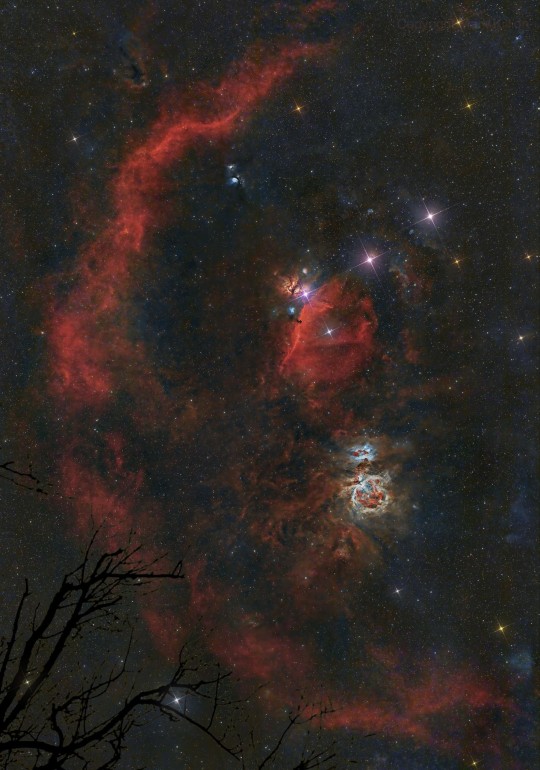
🌟NGC 2467 "Skull and Crossbones"🌟 Top 30
I have officially begin my TOP 30 Countdown of my most memorable astronomy photography of THREADS. Direct link is below 👇
This Photograph won Astronomy Photo of the year in 4 different Countries in 2020, 2021, 2022 and won 1 astronomy bronze award in 2022.
#astronomy#nasa#astronomers#universe#astrophotography#nasa photos#astrophysics#outer space#nasawebb#hubble space telescope#astronaut#astro community#astronauts#astro notes#astro observations#astroblr#astrology observations#planetary science#science facts#space science#science#space exploration#space#james webb space technology#planetary nebula#nebula#james webb space telescope#astronomy photography#hubble#our universe
49 notes
·
View notes
Photo
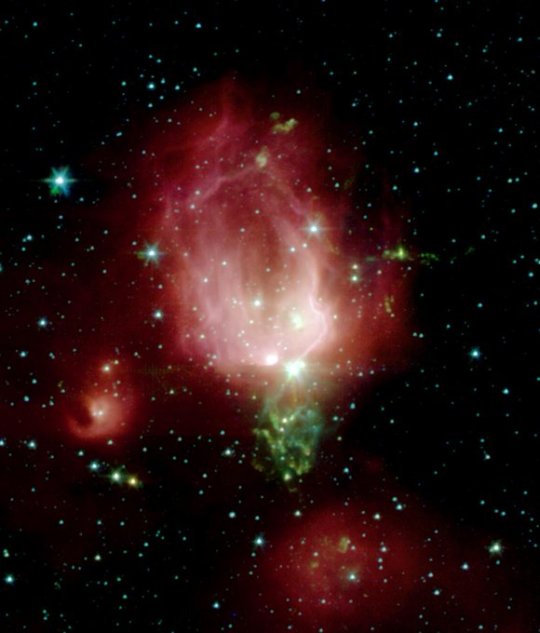
Spitzer Telescope
These bright young stars are found in a rosebud-shaped (and rose-colored) nebulosity known as NGC 7129. The star cluster and its associated nebula are located at a distance of 3300 light-years in the constellation Cepheus.
The Spitzer Space Telescope, formerly the Space Infrared Telescope Facility (SIRTF), was an infrared space telescope launched in 2003. Operations ended on 30 January 2020.
#spitzer telescope#spitzer space telescope#space infrared telescope facility#infrared space telescope#ngc 7129#constellation cepheus#nasa#nasa picture of the day#space#astronomy#rose#beauty#beautiful#pretty
15 notes
·
View notes
Text
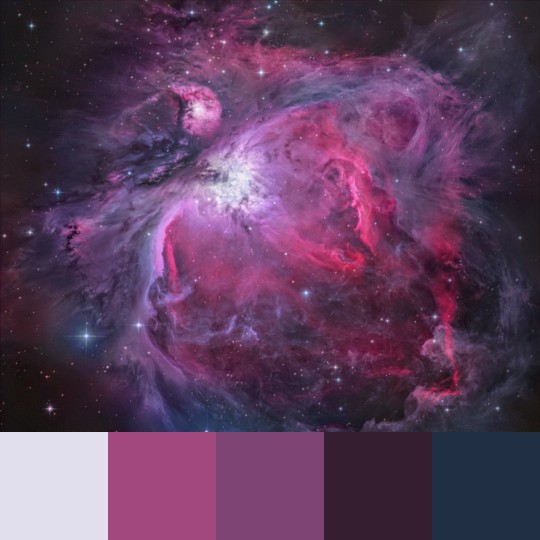
Space Gym: The Saga Continues - Research and Inspiration
Let's go forth with the saga of Space Gym (or why/how did I paint a space mural in my gym)! For part 1 (the origin story) see here:
I'll be honest with you, I am sometimes a person who gets very excited about something, tells everyone about wanting to do said thing, and then does not do it. For example, for a while, I talked about becoming a Zumba instructor. Do I like Zumba? Yeah! Do I like follow through: SOMETIMES. I'm just a human, after all.
So, I don't think it's a stretch to believe that BoP thought (hoped?) that my Space Gym idea would fade from reality. But, unluckily for him, I had a break from work coming up and I needed a project.
My initial thoughts for Space Gym was to get something like this (shameless plug for the podcast I cohost here: the one on the right goes along with Starry Time's Season 1 on the Zodiac constellations!):

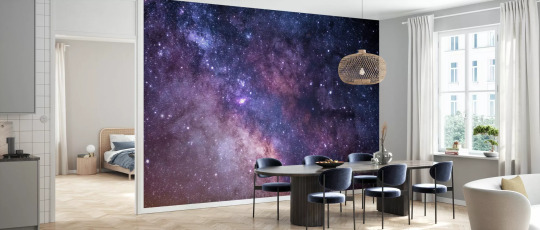
From Photowall via https://www.photowall.com/us/wall-murals/astronomy-space - L: Galaxy R: Zoodiac Sky IIII.
So, what is this witchcraft?? Peel and stick wallpaper.
Unfortunately, in addition to periodically lacking follow-through, I am also pretty cheap. The wallpaper was too expensive for the amount of wall I needed to cover. Plus, remember, BoP said I had to do this project without him -- and I don't know much about wallpaper, except it seems like a 2+ person job. PLUS, PLUS, it seemed like too much money to invest in something that was going to be in our gym (and the walls in the gym are a lil... uh... not flat, so it seemed like it would be too hard to do).
So, I did what any DIYer would do next and started scouring the internet for videos of people painting space murals. Here are two videos I watched that influenced my attempts at painting:
How to Paint a Space Wall Mural by Gray House Studio: https://youtu.be/Ct5Si2nm0KY
How to Paint a Space Nebula Galaxy Wall Mural by Home Decor Solutions: https://youtu.be/ADcfNusuEj8
Now is probably a good time to remind you that I have never painted anything (except walls with one color). I cannot stress this enough.
I.
Do.
Not.
Have.
Any.
Training.
I have never painted a mural. I have no art experience at all.
Why do I say this? Well, because (spoilers) these aren't the techniques that I ended up using for the central nebula. But, now, I'm getting ahead of myself.
So, I watched these videos and looked for photos of nebulas that I thought MAYBE I could paint.
Here are a few of the "inspiration" pictures I looked at:




What do we have here? Top left: Godzilla Nebula via https://www.jpl.nasa.gov/images/pia24579-godzilla-nebula-imaged-by-spitzer. Top Middle: Galaxy UGCA 193 via https://www.esa.int/ESA_Multimedia/Images/2020/11/A_waterfall_of_stars. Top Left: NGC 1858 via https://www.nasa.gov/image-feature/goddard/2022/hubble-spies-emission-nebula-star-cluster-duo/. Bottom: Dumbbell Nebula via https://www.nasa.gov/mission_pages/spitzer/multimedia/pia14417.html
Ultimately, though, I liked the colors and vibe of the Orion Nebula:

Orion Nebula via https://noirlab.edu/public/images/noao-02677/
Now, I had some inspiration and some color ideas to work with. Things were starting to become more real. I started telling people that Space Gym was happening. I showed people pictures of the Orion Nebula.
And, you know what, here are some more images of this rad nebula:



Other images of Orion Nebula via: L: CFHT/Coelum (J.-C. Cuillandre & G. Anselmi) M: https://www.esa.int/ESA_Multimedia/Images/2018/05/The_Orion_Nebula_also_known_as_M42 R: https://www.nasa.gov/image-feature/chaos-at-the-heart-of-the-orion-nebula
And my friends were like:

Which, you know, fair enough... but, I was undeterred, in part, because whatever I did couldn't be worse than the horrific sponge-painted murder wall. And, worst case, I'd just paint the wall black and we'd all pretend Space Gym was a fever dream.
So, I used the Coolors pallet generator (https://coolors.co/) to pick out colors from my inspiration photo(s):
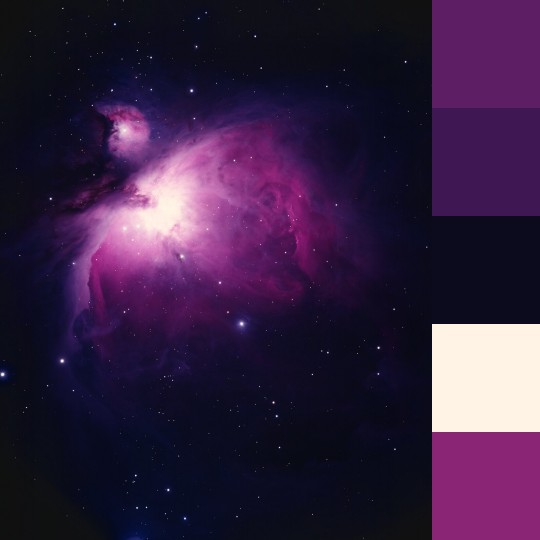

And off I went to the hardware store to order samples -- sorry to the person working who had to mix all of them.
And, here were my first attempts at nebulas (over that scary original wall). The middle one started out with promise, until I splattered paint, tried to fix it, and it turned out... poorly. The one of the far left, well, that looks like a straight up purple people eater. But the far right... well, that had potential! Though, admittedly, my belief in my ability to make anything look remotely like the Orion nebula was fading fast.
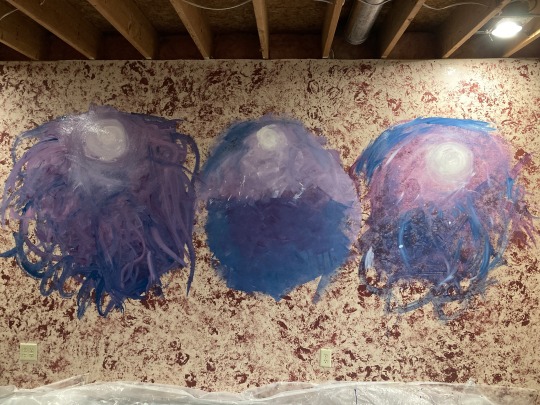
STILL. POTENTIAL. Better than I imagined!
Let's pause here, and I'll tell you what happened when I tried to bring my vision to scale next time!
3 notes
·
View notes
Text



Upper left: On October 30, 2022, Comet ZTF E3 displayed a blue-green coma, compact nuclear region and two tails — a curved, yellow dust tail and a very faint ion tail pointing straight up from the comet's head. Eduard Demencik
Upper right: Teardrop-shaped Comet ZTF (C/2020 V2) passed near the faint spiral galaxy NGC 3488 in Ursa Major on October 21, 2022.
Dan Bartlett
Lower: Comet ZTF E3 is currently plunging toward the plane of the solar system on a steeply inclined orbit. Its position is shown for November 16th. NASA HORIZONS
Ready to chase comets? We look at two fuzzy solar system travelers that will keep you on your toes all fall and winter long.
There are two 10th-magnitude comets now visible in the evening sky, both discovered by the Zwicky Transient Facility (ZTF) and bear its name — Comet ZTF (C/2020 V2) and Comet ZTF (C/2022 E3). The survey scans the entire northern sky every two nights using an exceptionally wide-field CCD camera on the 48-inch Samuel Oschin Telescope at Palomar Observatory.
Comet ZTF V2 still hovers around magnitude 10.5 as it inches north in the direction of Polaris at a current rate of about ½° per day. In mid-November the comet stands about 20° high at nightfall for observers at mid-northern latitudes and is circumpolar for much of the U.S. and Europe. Maximum altitude occurs just before dawn. An 8-inch or larger telescope under moonless skies should provide a good view of this compact cotton wad.
C/2020 V2 pole-vaults from Ursa Major to Sculptor between now and next October, slowly brightening to a peak magnitude of about 9.0–9.5 in late January and again in late August–early September during its closest approach to Earth on September 17, 2023. Along the way it gives the North Star a nod, passing 3.7° to its southeast on December 22nd and 0.8° west of the bright open cluster M103 in Cassiopeia on January 25th and 26th.
Comet ZTF (C/2022 E3) should become an order of magnitude more spectacular than its doppelgänger namesake. Staying put for now in northern Serpens near the Corona Borealis border, this small, strongly condensed comet glows around magnitude 9.8.
Come January 1st, Comet ZTF E3 quickly accelerates, crossing from Corona Borealis into Boötes, Draco, and Ursa Minor while brightening from magnitude 8 to 5–5.5 by month's end. During the third week of January it becomes circumpolar for mid-northern latitude observers and passes about 10° southeast of Polaris on January 29th. On the night of February 10–11 it pays a visit to Mars. Their separation tightens from about 1.5° during the early evening hours (comet northeast of Mars) to just under 1° before the planet sets. Before this cosmic snowball exits Taurus it buzzes past the Hyades from February 13–15.
Full article, pics, diagrams: https://skyandtelescope.org/astronomy-news/sneak-peek-at-two-promising-ztf-comets/
15 notes
·
View notes
Text
NGC2020 is an electronic music project mixing shoegaze, post-rock and ambient influences.
Born in Paris in 2020, NGC has previously released 3 EPs & 1 album and played several concerts with a live band, before coming back with a 4th EP: Feels Like Spring.
1 note
·
View note
